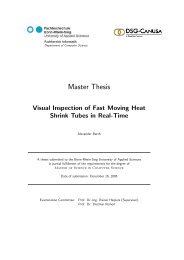Master Thesis - Hochschule Bonn-Rhein-Sieg
Master Thesis - Hochschule Bonn-Rhein-Sieg
Master Thesis - Hochschule Bonn-Rhein-Sieg
You also want an ePaper? Increase the reach of your titles
YUMPU automatically turns print PDFs into web optimized ePapers that Google loves.
4. Overall evading concept <strong>Master</strong> <strong>Thesis</strong> Björn Ostermann page 43 of 126<br />
intensity, the noise is worse in the corner of the image, where the intensity is lower. Another factor for<br />
noise is the vertical wall on the right side of the image, which causes problems due to its steep slope,<br />
because a small deviation in the horizontal measurement causes a large deviation in the vertical<br />
measurement, the distance measurement.<br />
The following subparts that are used to create data for the robot’s path planning are based upon the<br />
resulting intrusion image Figure 24d.<br />
4.3.4 Region growing and reachable space computation<br />
During the working process the program has to adjust the robot’s movements in order to avoid<br />
collisions between the robot and other objects. Therefore the positions of the robot and the dynamic<br />
objects in the environment have to be detected and the objects have to be avoided. As described above,<br />
single images have to be used, to achieve a real time application. The intrusion detection, described in<br />
the previous chapter, delivers single images that still contain little noise. The noise needs to be reduced<br />
further to identify the real intrusions. This is achieved by the subparts in this chapter by region<br />
growing and size differentiation. Additionally the robot has to be identified in the image to<br />
differentiate between dynamic objects that are obstacles for the robot and the robot itself. This is<br />
achieved by manual targeting by the user.<br />
To avoid dynamic objects two possibilities are implemented in this work, as described in chapter 2.3,<br />
and can both be activated by the user. One is the calculation of a flexible fence that defines the space<br />
the robot is not allowed to leave during its motion (reachable space) and the other is to control the<br />
robot’s speed by its distance to dynamic objects (approach control). To enable the path planning<br />
thread, described in chapter 4.4, to control the robot accordingly, the reachable space as well as the<br />
distance between the robot and the nearest object has to be known.<br />
The part four of the camera control thread, shown in Figure 25 contains the main subparts of the<br />
camera control thread that are active during the working time of the robot. These are the calculation of<br />
the reachable space (button 9) and the calculation of the distance between the robot and the nearest<br />
object (button 10).














